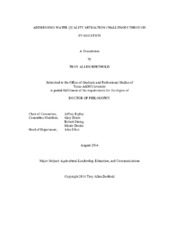| dc.description.abstract | The Arroyo Colorado River currently does not meet the State of Texas’ criteria for water quality. As a result, the Arroyo Colorado Watershed Protection Plan was developed, and implementation of the plan has been ongoing since 2007. Over the last few years, attendance at meetings and participation in education and incentive programs have decreased. Water quality can be restored only with individual participation; however, there has been a lack of information available to individuals to properly implement the Plan.
This study sought to collect data that will ultimately prioritize implementation efforts of the Arroyo Colorado Watershed Protection Plan. The research was conducted with agricultural producers in three counties of the Lower Rio Grande Valley of Texas: Cameron, Hidalgo, and Willacy counties.
Research questions for this study were 1) What are the primary educational needs for agricultural producers in Cameron, Hidalgo, and Willacy counties related to water, 2) What are the primary barriers to management practice adoption through incentive programs, and 3) What areas of the agricultural component of the Arroyo Colorado Watershed Protection Plan have been implemented effectively according to agricultural producer perception? Sixteen, eighteen, and twelve manifest variables (measurable variables), respectively, made up the primary constructs of this study. Of the 1,200 participants selected for this study, 63 questionnaires were undeliverable and 274 participants responded, resulting in a 24.1% response rate. Data were collected using mailed and internet surveys.
Results indicated that water quantity related variables were the primary educational need, followed by water quality, financial incentives, and conservation practice manifest variables. Primary barriers were related to economic manifest variables, followed by information/awareness, programmatic, and producer/operation. Finally, results indicated that education was the most effective component of the
program, followed by technical assistance, cost-share assistance, and monitoring and assessment. Further, significant differences between levels of various demographic variables could be identified in participants’ response to manifest variables. A key finding was that those who have heard of the Arroyo Colorado Watershed Protection Plan were more likely to have responded as having adopted sustainable agricultural practices than those who had not heard of the Plan.
Recommendations were made for education programs to focus on water quantity while bringing in aspects of water quality, followed by technical aspects of financial incentives and conservation practices. Avoiding barriers should consist of revising cost-share levels for the initial cost of installation and ensuring that cost-share assistance is readily available when it is requested. Finally, to improve the program, monitoring and assessment projects should do a better job of relaying information about conservation practice effectiveness, which also ties back into some of the barriers and educational needs related to water. | en |


